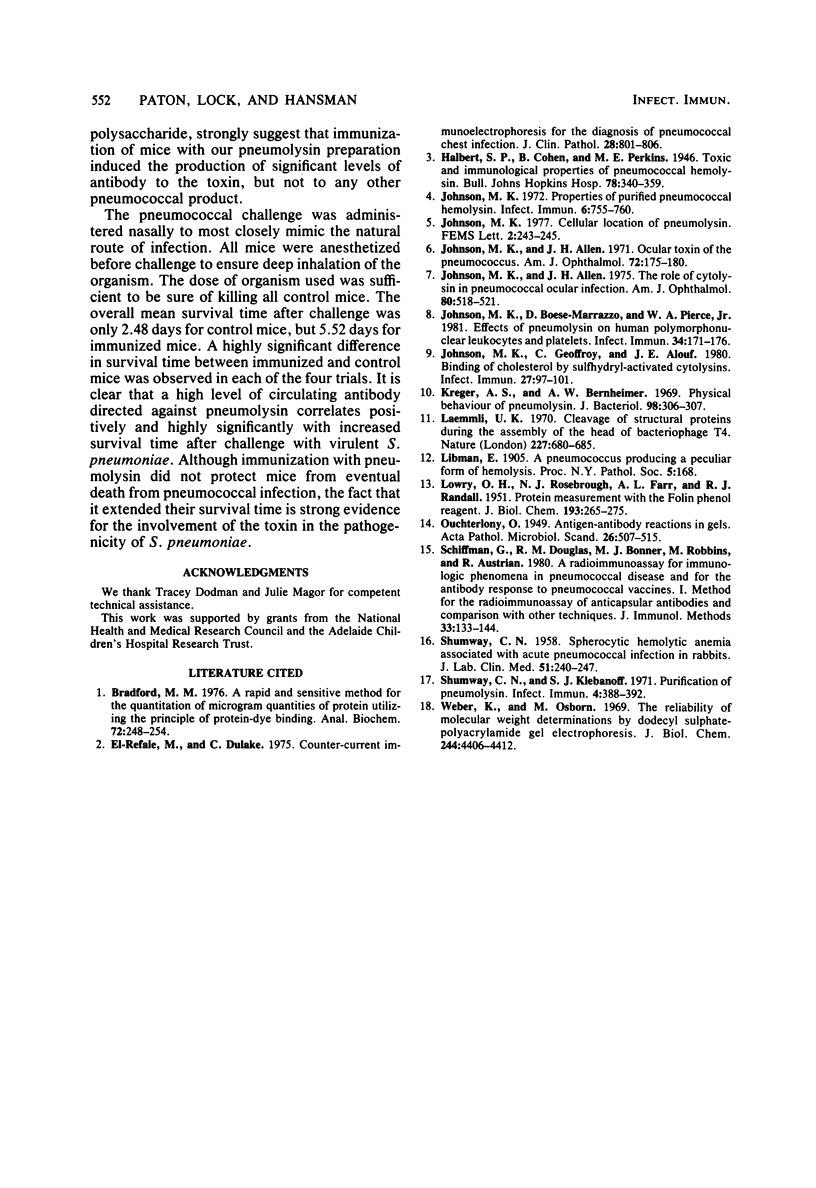Abstract
The role of the cytolytic toxin pneumolysin in the pathogenicity of Streptococcus pneumoniae was investigated. Pneumolysin was purified to homogeneity and used to immunize mice. When these mice were subsequently challenged via the nasal route with virulent S. pneumoniae, they survived significantly longer than control mice. The mean survival times were 5.52 and 2.48 days for immunized and control mice, respectively. This work provides direct evidence for the involvement of pneumolysin in pneumococcal pathogenicity.
Full text
PDF




Images in this article
Selected References
These references are in PubMed. This may not be the complete list of references from this article.
- Bradford M. M. A rapid and sensitive method for the quantitation of microgram quantities of protein utilizing the principle of protein-dye binding. Anal Biochem. 1976 May 7;72:248–254. doi: 10.1016/0003-2697(76)90527-3. [DOI] [PubMed] [Google Scholar]
- El-Refaie M., Dulake C. Counter-current immunoelectrophoresis for the diagnosis of pneumococcal chest infection. J Clin Pathol. 1975 Oct;28(10):801–806. doi: 10.1136/jcp.28.10.801. [DOI] [PMC free article] [PubMed] [Google Scholar]
- Johnson M. K., Allen J. H. Ocular toxin of the pneumococcus. Am J Ophthalmol. 1971 Jul 30;72(1):175–180. doi: 10.1016/0002-9394(71)91610-2. [DOI] [PubMed] [Google Scholar]
- Johnson M. K., Allen J. H. The role of cytolysin in pneumococcal ocular infection. Am J Ophthalmol. 1975 Sep;80(3 Pt 2):518–521. doi: 10.1016/0002-9394(75)90219-6. [DOI] [PubMed] [Google Scholar]
- Johnson M. K., Boese-Marrazzo D., Pierce W. A., Jr Effects of pneumolysin on human polymorphonuclear leukocytes and platelets. Infect Immun. 1981 Oct;34(1):171–176. doi: 10.1128/iai.34.1.171-176.1981. [DOI] [PMC free article] [PubMed] [Google Scholar]
- Johnson M. K., Geoffroy C., Alouf J. E. Binding of cholesterol by sulfhydryl-activated cytolysins. Infect Immun. 1980 Jan;27(1):97–101. doi: 10.1128/iai.27.1.97-101.1980. [DOI] [PMC free article] [PubMed] [Google Scholar]
- Johnson M. K. Properties of purified pneumococcal hemolysin. Infect Immun. 1972 Nov;6(5):755–760. doi: 10.1128/iai.6.5.755-760.1972. [DOI] [PMC free article] [PubMed] [Google Scholar]
- Kreger A. S., Bernheimer A. W. Physical behavior of pneumolysin. J Bacteriol. 1969 Apr;98(1):306–307. doi: 10.1128/jb.98.1.306-307.1969. [DOI] [PMC free article] [PubMed] [Google Scholar]
- LOWRY O. H., ROSEBROUGH N. J., FARR A. L., RANDALL R. J. Protein measurement with the Folin phenol reagent. J Biol Chem. 1951 Nov;193(1):265–275. [PubMed] [Google Scholar]
- Laemmli U. K. Cleavage of structural proteins during the assembly of the head of bacteriophage T4. Nature. 1970 Aug 15;227(5259):680–685. doi: 10.1038/227680a0. [DOI] [PubMed] [Google Scholar]
- SHUMWAY C. N., Jr Spherocytic hemolytic anemia associated with acute pneumococcal infection in rabbits. J Lab Clin Med. 1958 Feb;51(2):240–247. [PubMed] [Google Scholar]
- Schiffman G., Douglas R. M., Bonner M. J., Robbins M., Austrian R. A radioimmunoassay for immunologic phenomena in pneumococcal disease and for the antibody response to pneumococcal vaccines. I. Method for the radioimmunoassay of anticapsular antibodies and comparison with other techniques. J Immunol Methods. 1980;33(2):133–144. doi: 10.1016/s0022-1759(80)80004-4. [DOI] [PubMed] [Google Scholar]
- Shumway C. N., Klebanoff S. J. Purification of pneumolysin. Infect Immun. 1971 Oct;4(4):388–392. doi: 10.1128/iai.4.4.388-392.1971. [DOI] [PMC free article] [PubMed] [Google Scholar]
- Weber K., Osborn M. The reliability of molecular weight determinations by dodecyl sulfate-polyacrylamide gel electrophoresis. J Biol Chem. 1969 Aug 25;244(16):4406–4412. [PubMed] [Google Scholar]




